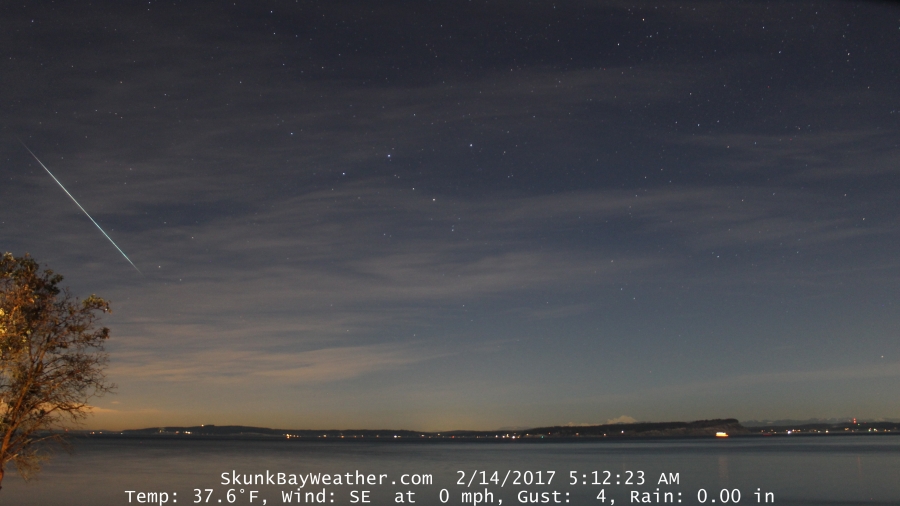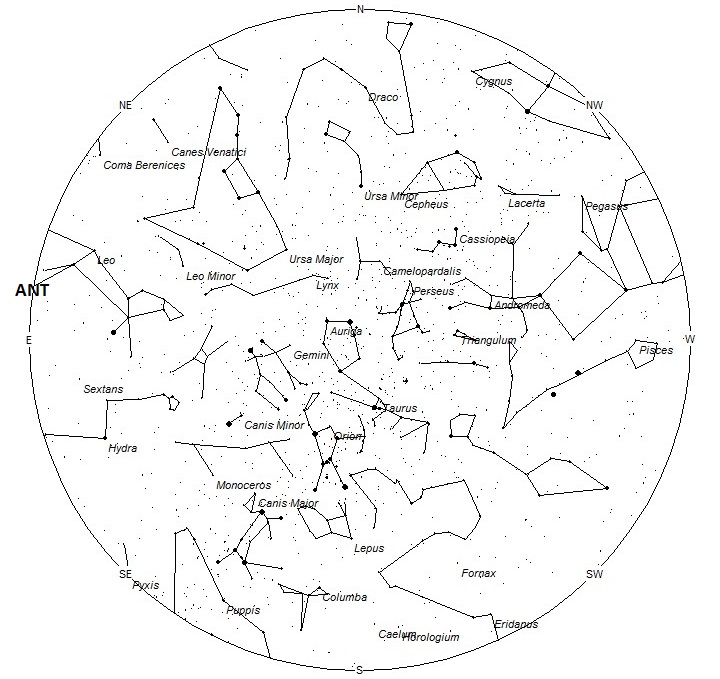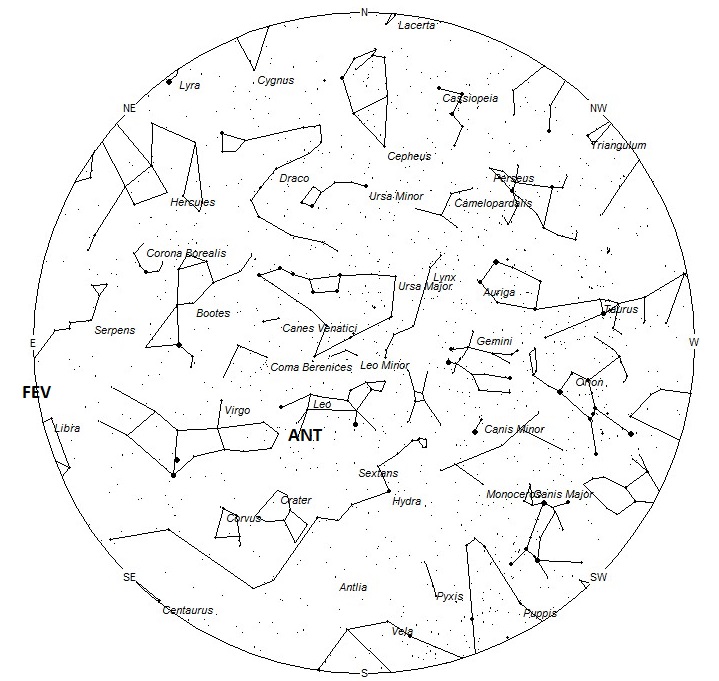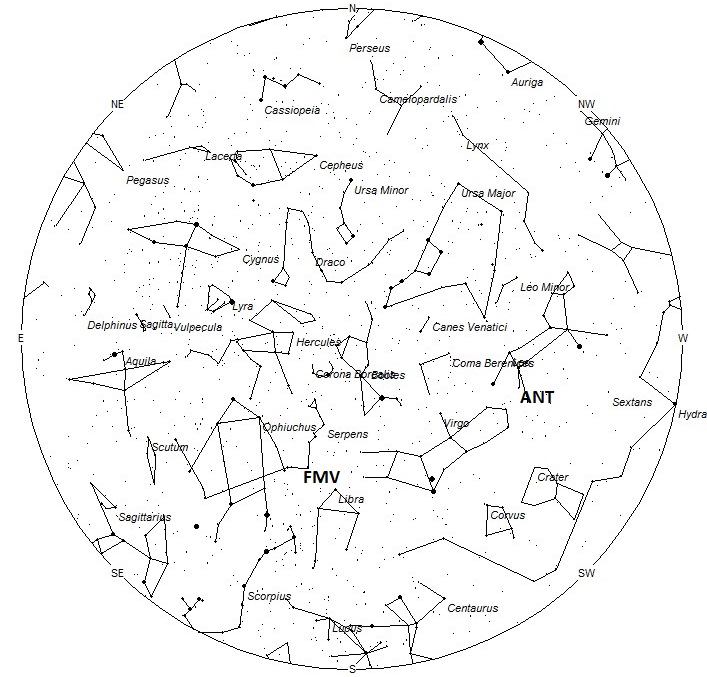
During this period the moon starts out just slightly less than half illuminated and wanes down to a thin sliver, rising just before the sun. This weekend the moon rises near 0100 as seen from mid-northern latitudes. It’s nearly half illuminated and still bright but it does not possess the overpowering effect on faint objects that the full moon does. One can hold successful meteor viewing sessions this week by simply facing away from the moon toward darker portions of the sky. You can also view before the moon rises but February evenings are dreadfully slow as seen from the northern hemisphere. The estimated total hourly meteor rates for evening observers this week is near 3 for those viewing from the northern hemisphere and 4 for those located south of the equator. For morning observers the estimated total hourly rates should be near 7 as seen from mid-northern latitudes (45N) and 14 as seen from tropical southern locations (25S) Morning rates are reduced due to moonlight. The actual rates will also depend on factors such as personal light and motion perception, local weather conditions, alertness and experience in watching meteor activity. Note that the hourly rates listed below are estimates as viewed from dark sky sites away from urban light sources. Observers viewing from urban areas will see less activity as only the brightest meteors will be visible from such locations.
The radiant (the area of the sky where meteors appear to shoot from) positions and rates listed below are exact for Saturday night/Sunday morning February 18/19. These positions do not change greatly day to day so the listed coordinates may be used during this entire period. Most star atlases (available at science stores and planetariums) will provide maps with grid lines of the celestial coordinates so that you may find out exactly where these positions are located in the sky. A planisphere or computer planetarium program is also useful in showing the sky at any time of night on any date of the year. Activity from each radiant is best seen when it is positioned highest in the sky, either due north or south along the meridian, depending on your latitude. It must be remembered that meteor activity is rarely seen at the radiant position. Rather they shoot outwards from the radiant so it is best to center your field of view so that the radiant lies at the edge and not the center. Viewing there will allow you to easily trace the path of each meteor back to the radiant (if it is a shower member) or in another direction if it is a sporadic. Meteor activity is not seen from radiants that are located below the horizon. The positions below are listed in a west to east manner in order of right ascension (celestial longitude). The positions listed first are located further west therefore are accessible earlier in the night while those listed further down the list rise later in the night.
These sources of meteoric activity are expected to be active this week.
.
The center of the large Anthelion (ANT) radiant is currently located at 11:00 (165) +06. This position lies in southern Leo, 4 degrees west of the 4th magnitude star known as sigma Leonis. Due to the large size of this radiant, Anthelion activity may also appear from Sextans and western Virgo as well as southern Leo. This radiant is best placed near 0100 local standard time (LST), when it lies on the meridian and is located highest in the sky. Rates at this time should be near 2 per hour no matter your location. With an entry velocity of 30 km/sec., the average Anthelion meteor would be of slow velocity.
The alpha Centaurids (ACE) are active from January 28 though February 21, with maximum activity occurring on February 8. The radiant is currently located at 14:52 (223) -62. This position lies in southeastern Centaurus only 2 degrees west of the brilliant zero magnitude star known as Rigel Kentaurus (Alpha Centauri). Due to the southern declination of this radiant, these meteors are not well seen in the northern hemisphere. Current rates would be near 1 per hour as seen from the southern hemisphere and less than 1 from the northern hemisphere. These meteors are best seen near 0500 LST when the radiant lies highest above the horizon. At 56 km/sec. the Alpha Centaurids would produce mostly swift meteors.
The February Mu Virginids (FMV) were discovered by Damir Šegon and colleagues from the Croatian Meteor Network using their data and that of SonotaCo. These meteors are active from February 15 through March 4 with maximum activity occurring on February 26. The current radiant position lies near 15:28 (232) -05, which actually places it northern Libra, 5 degrees northeast of the 3rd magnitude star known as Zubeneschamali (beta Librae). Rates are expected to be less than 1 per hour no matter your location. These meteors are best seen near 0500 LST when the radiant lies highest above the horizon. At 62 km/sec. the February Mu Virginids would produce mostly swift meteors.
As seen from the mid-northern hemisphere (45N) one would expect to see approximately 5 sporadic meteors per hour during the last hour before dawn as seen from rural observing sites. Evening rates would be near 2 per hour. As seen from the tropical southern latitudes (25S), morning rates would be near 11 per hour as seen from rural observing sites and 3 per hour during the evening hours. Locations between these two extremes would see activity between the listed figures. Morning rates are reduced due to moonlight.
| SHOWER | DATE OF MAXIMUM ACTIVITY | CELESTIAL POSITION | ENTRY VELOCITY | CULMINATION | HOURLY RATE | CLASS |
| RA (RA in Deg.) DEC | Km/Sec | Local Standard Time | North-South | |||
| Anthelion (ANT) | – | 11:00 (165) +06 | 30 | 01:00 | 2 -2 | II |
| alpha Centaurids (ACE) | Feb 08 | 14:52 (223) -62 | 56 | 05:00 | <1 – 1 | II |
| February mu Virginids (FMV) | Feb 26 | 15:28 (232) -05 | 64 | 05:00 | <1 – <1 | IV |
 American Meteor Society
American Meteor Society



We just saw one in Nashu NH!!! It was incredible